
Saint Helena is one of the three constituent parts of Saint Helena, Ascension and Tristan da Cunha, a British overseas territory located in the South Atlantic Ocean. Saint Helena is a remote volcanic tropical island 1,950 km (1,210 mi) west of the coast of south-western Africa, and 4,000 km (2,500 mi) east of Rio de Janeiro in South America.
Saint Helena has a known history of over 500 years since its recorded discovery by the Portuguese in 1502. Claiming to be Britain's second oldest colony, after Bermuda, this is one of the most remote settlements in the world and was for several centuries of vital strategic importance to ships sailing to Europe from Asia and South Africa. Since the early 19th century, the British occasionally used the island as a place of exile, most notably for Napoleon Bonaparte, Dinuzulu kaCetshwayo and over 5,000 Boer prisoners.
Saint Helena, Ascension and Tristan da Cunha are British Overseas Territories in the south Atlantic Ocean.
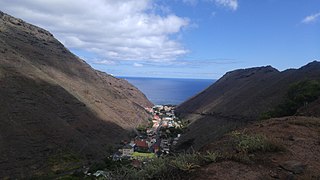
Jamestown is the capital city of the British Overseas Territory of Saint Helena, Ascension and Tristan da Cunha, located on the island of Saint Helena in the South Atlantic Ocean. It is also the historic main settlement of the island and is on its north-western coast. Before the development of the port at Rupert's Bay, it was the island's only port and the centre of the island's road and communications network. It was founded when colonists from the English East India Company settled on the island in 1659 and was briefly occupied by the Dutch East India Company in 1673 before being recaptured. Many of the buildings built by the East India Company in the 18th century survive and give the town its distinctive Georgian flavour.

Longwood is a settlement and a district of the British island of Saint Helena in the South Atlantic Ocean.
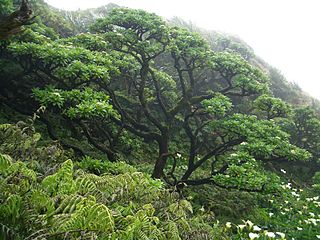
The Saint Helena scrub and woodlands ecoregion covers the volcanic island of Saint Helena in the South Atlantic Ocean. The island's remote location gave rise to many endemic species. First discovered and settled in the 1500s, the island has been degraded by human activities. Most of its native habitat has been destroyed, and many of its unique plants and animals are extinct or endangered.
My Saint Helena Island is the unofficial regional anthem of Saint Helena. It was written by Dave Mitchell in 1975, after persuasion from the inhabitants of Saint Helena. As a British Overseas Territory, the national anthem is "God Save the King".

Half Tree Hollow is the smallest by area of the eight districts of the island of Saint Helena, part of the British Overseas Territory of Saint Helena, Ascension and Tristan da Cunha in the South Atlantic Ocean. It is a suburb of Jamestown and is situated at the top of Ladder Hill, which forms the southern side of the James Valley, at the base of which sits Jamestown. The hill was fortified in the late 1700s, and Ladder Hill Fort was subsequently built. The village grew during the 1960s because the James Valley lacked any room for expansion.
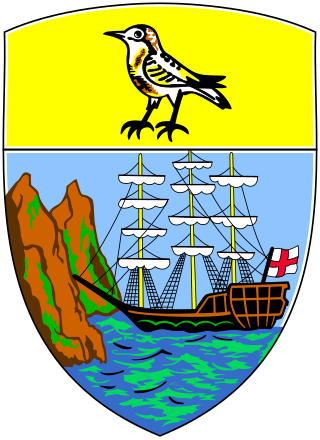
The Legislative Council of Saint Helena is the unicameral legislature of Saint Helena, a constituent part of the British Overseas Territory of Saint Helena, Ascension and Tristan da Cunha. The council itself is often referred to as "LegCo" by islanders.

Blue Hill is one of eight districts of the island of Saint Helena, part of the British Overseas Territory of Saint Helena, Ascension and Tristan da Cunha in the South Atlantic Ocean. It is sparsely populated and comprises the western third of the island. The district is entirely agricultural with no industrial activity.

Briars is the small pavilion in which Napoleon Bonaparte stayed for the first few weeks of his exile on Saint Helena in late 1815 before being moved to Longwood House.

The Diocese of Saint Helena is an Anglican diocese within the Anglican Church of Southern Africa. It covers the islands of Saint Helena and Ascension in the Atlantic Ocean and was created in 1859. St Paul's Cathedral is on Saint Helena.

Alarm Forest is the newest of the eight districts of the island of Saint Helena, part of the British Overseas Territory of Saint Helena, Ascension and Tristan da Cunha in the South Atlantic Ocean. It is located southeast of Jamestown, in the interior of the island, and is the only district to lack a coastline.
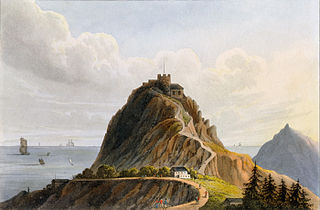
High Knoll Fort is a redoubt-style fort of the English East India Company on Saint Helena, an island and British overseas territory in the South Atlantic Ocean. High Knoll is 584 metres (1,916 ft) above sea level and is approximately one mile (1.6km) south of historic Lower Jamestown. Reopened on 18 December 2010, it is now a tourist attraction for visitors, especially those on the tourist ships that come in the summer.

The politics of Saint Helena, Ascension and Tristan da Cunha operate under the jurisdiction of the government of the United Kingdom. The three parts of the territory—Saint Helena, Ascension Island and Tristan da Cunha—effectively form an asymmetric federacy and collectively constitute one of United Kingdom's fourteen overseas territories.

Sandy Bay is one of eight districts of the island of Saint Helena, part of the British Overseas Territory of Saint Helena, Ascension and Tristan da Cunha in the South Atlantic Ocean. Located on the island's southeastern coast, it is sparsely populated and is a popular recreation site.
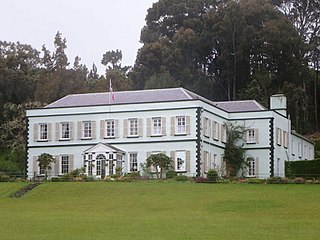
Plantation House is the official residence of the governor of Saint Helena. It is located 3.6 km (2.2 mi) to the south of the capital, Jamestown, on the island of Saint Helena.

Saint Paul's Cathedral is a cathedral church on the island of St Helena and is part of the Diocese of St Helena. It is located approximately 2 miles south of Jamestown in the district of St Paul's.

The Castle is the main government building of the British Overseas Territory of Saint Helena, Ascension and Tristan da Cunha, located in Jamestown on the island of Saint Helena. A Grade I-listed building, the oldest parts of the complex date to 1708, but it was largely reconstructed in the 1860s because of termite damage. It does not have the appearance of a typical castle, though historically the site was part of the East India Company fortifications of Jamestown.
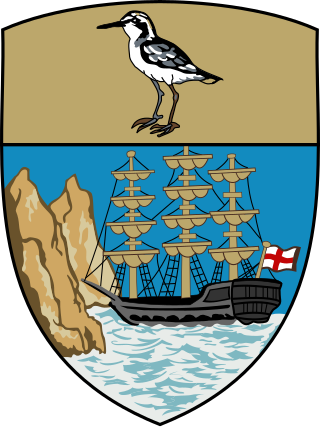
Trade unions in Saint Helena emerged in the late 1950s in the flax industry and subsequently played a prominent role in the island's democratisation in the 1960s. The Saint Helena General Workers Union was the island's sole trade union throughout the latter half of the 20th century. In the 21st century, workers are mostly organised in the public sector in staff associations for nurses, teachers and public servants.



























